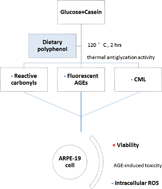Treatment of proteins with dietary polyphenols lowers the formation of AGEs and AGE-induced toxicity
Abstract
Advanced glycation endproducts (AGEs) are a group of harmful compounds produced either endogenously or during thermal food processing. Once absorbed by humans via food intake, AGEs can cause oxidative cell damage and contribute to pathological development of various diseases. The AGE-inhibitory activity of dietary polyphenols in vitro has been extensively reported before, but the current study is pioneering in examining the antiglycation activity of five selected dietary polyphenols (phloretin, naringenin, epicatechin, chlorogenic acid, and rosmarinic acid) during the thermal protein glycation process. When added into the glucose–casein glycation model heated at 120 °C for 2 h, these polyphenols were capable of inhibiting the formation of both total fluorescent AGEs and nonfluorescent carboxymethyllysine (CML). The thermal stability and transformation of polyphenols are likely important factors affecting their antioxidant activity and inhibitory efficacy of reactive carbonyl species formation. Treatment with epicatechin would lower not only AGE formation but also AGE-induced cytotoxicity and oxidative stress to human retinal pigment epithelial (ARPE-19) cells.


 Please wait while we load your content...
Please wait while we load your content...